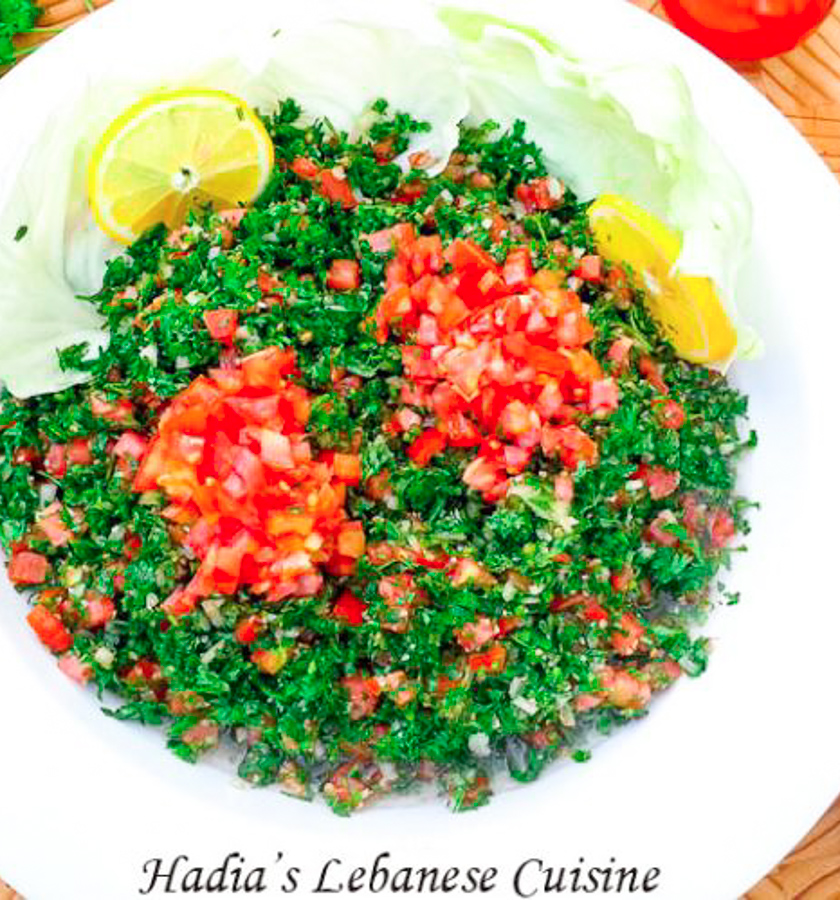
Tabbouleh
High Fiber, No refined sugar, Vegan, Vegetarian
Tabbouleh
Most probably you have had tabbouleh at a Lebanese or Middle Eastern restaurant, It is the mother of all Lebanese salads and one of my favorite green salads of all time and a treat year round at our home and the homes of Lebanese around the world. No gathering is complete without a decent bowl of tabbouleh brought together with Romain lettuce or cabbage leaves, the appeal of a beautiful tabbouleh bowl aws as much to its color palette as to its vibrant flavor!

Parsley is known as an excellent blood purifier and high in minerals like calcium, potassium, magnesium, copper and zinc and has a high amount of antioxidants that delay the signs of ageing. Skip the cleanse and eat tabbouleh! How wonderful it is when healthy is delicious!
The most time-consuming part is washing, drying and finely chopping the parsley (ofcourse hand chopping). Tabbouleh is best eaten by hand scooped up with fresh vine leaf/ Romaine lettuce leaf/ cabbage leaf, sounds odd? Believe me it is the best way to enjoy tabbouleh!
- I recommend you give the parsley leaves a good washing. Place in a sink of water, submerge the leaves, add a pinch of salt and agitate. Let the leaves soak for 5 minutes and drain. Then rinse with clear running water until all signs of soil are removed.

Tips and Tricks for an authentic Lebanese Tabbouleh
- In Lebanon flat-leaf parsley is commonly used, the leaves are more tender, and their flavor is deeper and sweeter than the curly variety, but it is still doable with the curly parsley.
- Try to pick the freshest herbs (parsley and mint leaves).
- Wash the parsley leaves and transfer to a colander to dry out.
- Parsley should be dry before cutting.
- Divide the parsley to small bunches, take each bunch by holding it down and chopping it with a sharp knife, shave into strips, making sure to leave the lower tough stems behind (they negatively affect the taste).
- Finely chop the parsley leaves using a sharp knife. A sharp knife slices cleanly through the leaves, preserving flavor and avoiding a mushy tabbouleh.
- An important factor is to remember that tabbouleh is a way of eating parsley not bulgur, so there should be very little bulgur.
- Use red, ripe, and firm tomatoes for best resluts. Avoid those soft or mushy tomatoes that tend to leak fluid underneath, they will ruin your tabbouleh.
- Bulgur wheat comes in different size grains, use fine bulgur to make tabbouleh, that is why you can toss it directly with the salad, no need to cook or hydrate. the fine bulgur will soak up the juice in the tabbouleh.
- Parsley, onions and mint leaves can be chopped ahead of time (for a couple of hours) and mixed and kept in the fridge, covered with cling film; tomatoes as well can diced and stored separately in the fridge until ready to mix up before serving.
- Juice the fresh lemon right before mixing, simply because lemon goes bitter when stored for later.
- Seven spice/ allspice is commonly used to season tabbouleh, my personal preference is seven spice.
- Use best olive oil for tabbouleh, I use Lebanese olive oil, you can use your favorite extra virgin olive oil brand.
- Don’t mix and dress the tabbouleh until you need to serve it.
- If you are a pomegranate molasses lover, like me, drizzle some on your tabbouleh, it adds a zing of tartness.
TO PIN IT
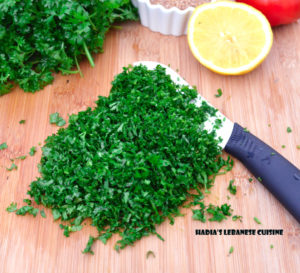
- A last important factor is to remember that tabbouleh is a way of eating parsley not bulgur, so there should be very little bulgur.
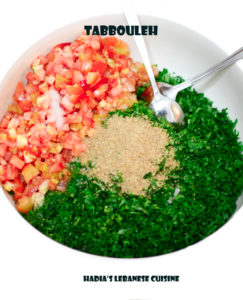

Divide the parsley to small bunches, take each bunch by holding it down and chopping it with a sharp knife, shave into strips, making sure to leave the lower tough stems behind (they negatively affect the taste). Finely chop the parsley leaves using a sharp knife. A sharp knife slices cleanly through the leaves, preserving flavor and avoiding a mushy tabbouleh.
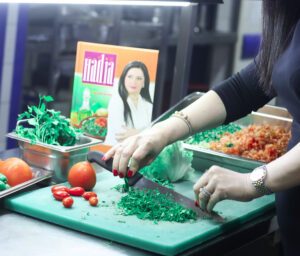
Ingredients:
- 3 large bunches or about 6 cups parsley, finely chopped, stems removed and use only the leaves
- 5 medium-sized tomatoes, finely diced
- 7 leaves fresh mint
- 1 medium-sized white onion, finely chopped
- 1/2 cup extra virgin olive oil
- 1/4 cup of freshly squeezed lemon juice
- Salt to taste
- 2 tablespoons fine bulgur (cracked wheat)
- A dash of allspice, or seven spice
Directions:
- Remove and pick out any imperfect parsley leaves. Discarde the stems too.
- Place the parsley in salted water and soak for 5 minutes, then rinse with clear running water and drain in a colander. Set aside until the leaves are completely dry. Repeat with the mint leaves.
- Finely chop the parsley leaves, using a sharp knife.
- Finely chop the mint leaves.
- Mix the parsley, tomatoes, mint, and onion.
- Add the lemon juice, bulgur, olive oil, salt, and spice. Mix well.
- Pour into a serving dish and decorate with cabbage leaves.
- Note: Parsley should be dry before cutting. Make sure to use a sharp knife to chop parsley. A sharp knife slices cleanly through the leaves, preserving flavor and avoiding a mushy tabbouleh. A last important factor is to remember that tabbouleh is a way of eating parsley not bulgur, so there should be very little bulgur. Enjoy!
If you make this recipe, share your pictures on Facebook! I would love to see your creations!Hashtag them #Hadia's Lebanese Cuisine
.
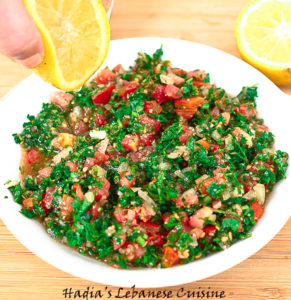
Subscribe to Our Newsletter
Instructions
No Steps Found !
- Course : APPETIZERS, SALADS
- Recipe Type : LEBANESE RECIPES, SALAD, SALAD
- Ingredient : Lemon, Olive Oil, Parsley, Tomatoes
18 Responses to Tabbouleh
Leave a Reply to Robin Daumit Click here to cancel reply.
About Chef
Hadia Zebib
I am Hadia, the face behind Hadia’s Lebanese Cuisine. I grew up in Beirut Lebanon and I currently reside in Kinshasa, Congo with my husband and my three adorable sons, ...
Read more about this chef..

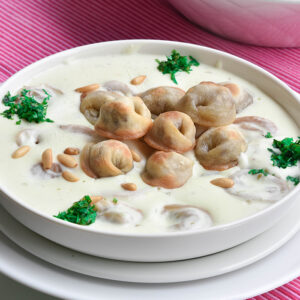
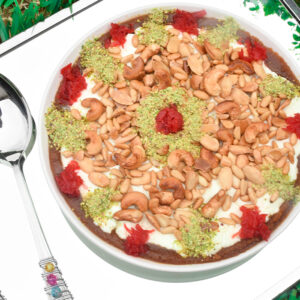


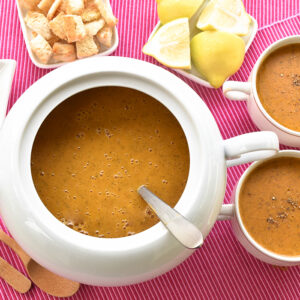
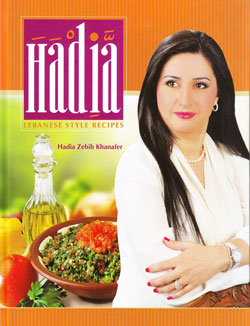
Why do you not wash drains and squeeze the bur’ghul first and leave in the fridge until the rest of the salad is done? It allows the bur’ghul to soften somewhat ? I use 2 teaspoons of Salt which is usually added to the onions, along with 1/4 teaspoon of black pepper and 1/4 teaspoon of mixed spice. This allows the onion to marinate and cold cook removing its raw taste so to speak. Also, I have always used 1/4 cup of each Extra Virgin Olive oil and lemon juice.. Anyway, I hope I have not offended you but I have made it this way for 40 years with most people suggesting its the best they have had. Its mums recipe not mine so I don’t accept accolades.
Charles,many culinary enthusiasts emphasize authenticity, but still ask a group of Lebanese how to make tabbouleh, and you will open a discussion! Each person has their own version, and all could be right!!There is always a room for personal preference in cooking! I can totally understand your point, so not at all offended. I prefer to add the bulgur (dry), since it absorbs the juices! That’s my favorite way of making tabbouleh!! Xo xo!
I agree with you. My mum always used tomatoes to soak the bulgur in the tabouleh. She also taught me that the greens should be completely dry before they are chipped to get the best taste. Thank you for your sharing Hadia
Absolutely, Jenny! The key to a successful tabouleh is to dry the parsley and mint leaves before cutting. You are welcome. Xoxo
I love authentic food thanks for sharing
Thank you, Claudia! Xo xo!
Hadia! What a beautiful recipe! I will be making this. A question, could I substitute (cooked) barley for bulgur? Will I achieve the similar absorption? I’m thinking I want a little more texture. Just a thought as I know you love personal preferences in recipes! xo ~ally
Thank you so much, Ally!! Traditionally, bulgur is a major component in tabbouleh, but of course, as you mentioned, there is always a room for personal preference, and I would imagine that tabbouleh would be tasty too with barely – with its slightly chewy texture it will absorb the juices coming from tabbouleh. Let me know how it turns out for you with barely! Xo xo
I can’t wait to try making this
Oh Hadia! My all time favorite Lebanese salad, your food always knows its way to my heart!!
Tabbouleh! Now that’s one I recognize! LOL Parsley! That’s your secret! Love it!
Love this. Must try it.
Hadi
Thank you for sharing! I am so anxious to make this. I just returned from Berlin where I got to enjoy some fantastic Lebanese food at my dad favorite restaurant that has me longing for more, but I’m back in Hawaii where there is a serious shortage of good Lebanese food.
Thank you Caroline, I hope you enjoy it as much as we do. Let me know how it turns out for you!
This sounds great! I make it similarly, but I use more mint and less onion. I also pre soak the bulgur. I don’t put any spices in it at all, but I add a sprinkle of cayenne or finely chopped green chili pepper to my personal plate. I never measure anything when I make Lebanese food, I just know I love lemon, so I put plenty of it. I also love pomegranate syrup, but have only had it with two dishes, fatoush and stuffed cabbage leaves.
Salaam Haida,
Followed your way of making this salad to a tee, the end result was superb… thank you for sharing ( I know I can count on you for all Lebanese recipes 😘🙌🏽)
Andi
Oh, and I apologize for misspelling your name…. Typos 😏😁
That’s great to hear,Andy. Happy you enjoyed, and thanks for leaving your review. Xoxo